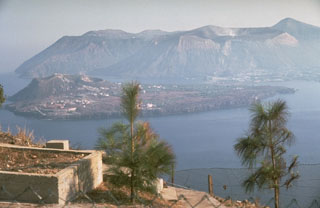Report on Vulcano (Italy) — April 1995
Bulletin of the Global Volcanism Network, vol. 20, no. 4 (April 1995)
Managing Editor: Richard Wunderman.
Vulcano (Italy) Fumaroles at Fossa Grande and Forgia Vecchia craters
Please cite this report as:
Global Volcanism Program, 1995. Report on Vulcano (Italy) (Wunderman, R., ed.). Bulletin of the Global Volcanism Network, 20:4. Smithsonian Institution. https://doi.org/10.5479/si.GVP.BGVN199504-211050
Vulcano
Italy
38.404°N, 14.962°E; summit elev. 500 m
All times are local (unless otherwise noted)
During an 18 Apri visit by Boris Behncke to the Fossa Grande crater the most vigorous fumaroles were present on the N inner crater rim and near its bottom. The main focus of fumarolic activity had shifted notably from the crater rim towards its center since his March 1992 visit (BGVN 17:03). Some of the spectacular fissures on the outer N crater wall were inactive, but several large fumaroles had formed near the crater floor. Molten sulfur was present in many fumaroles on the crater rim. Fumarolic activity on the oversteepened S part of the 18th century Forgia Vecchia craters and on the upper SE slope of the cone has changed little since 1992. Fumaroles were also active at Gran Cratere in October 1994.
Geological Summary. The word volcano is derived from Vulcano stratovolcano in Italy's Aeolian Islands. Vulcano was constructed during six stages over the past 136,000 years. Two overlapping calderas, the 2.5-km-wide Caldera del Piano on the SE and the 4-km-wide Caldera della Fossa on the NW, were formed at about 100,000 and 24,000-15,000 years ago, respectively, and volcanism has migrated north over time. La Fossa cone, active throughout the Holocene and the location of most historical eruptions, occupies the 3-km-wide Caldera della Fossa at the NW end of the elongated 3 x 7 km island. The Vulcanello lava platform is a low, roughly circular peninsula on the northern tip of Vulcano that was formed as an island beginning more than 2,000 years ago and was connected to the main island in about 1550 CE. Vulcanello is capped by three pyroclastic cones and was active intermittently until the 16th century. Explosive activity took place at the Fossa cone from 1898 to 1900.
Information Contacts: Giada Giuntoli and Boris Behncke, GEOMAR Research Center, Dept. of Volcanology and Petrology, Christian-Albrechts-Universitat zu Kiel, Wischhofstr. 1-3, 24148 Kiel, Germany.

